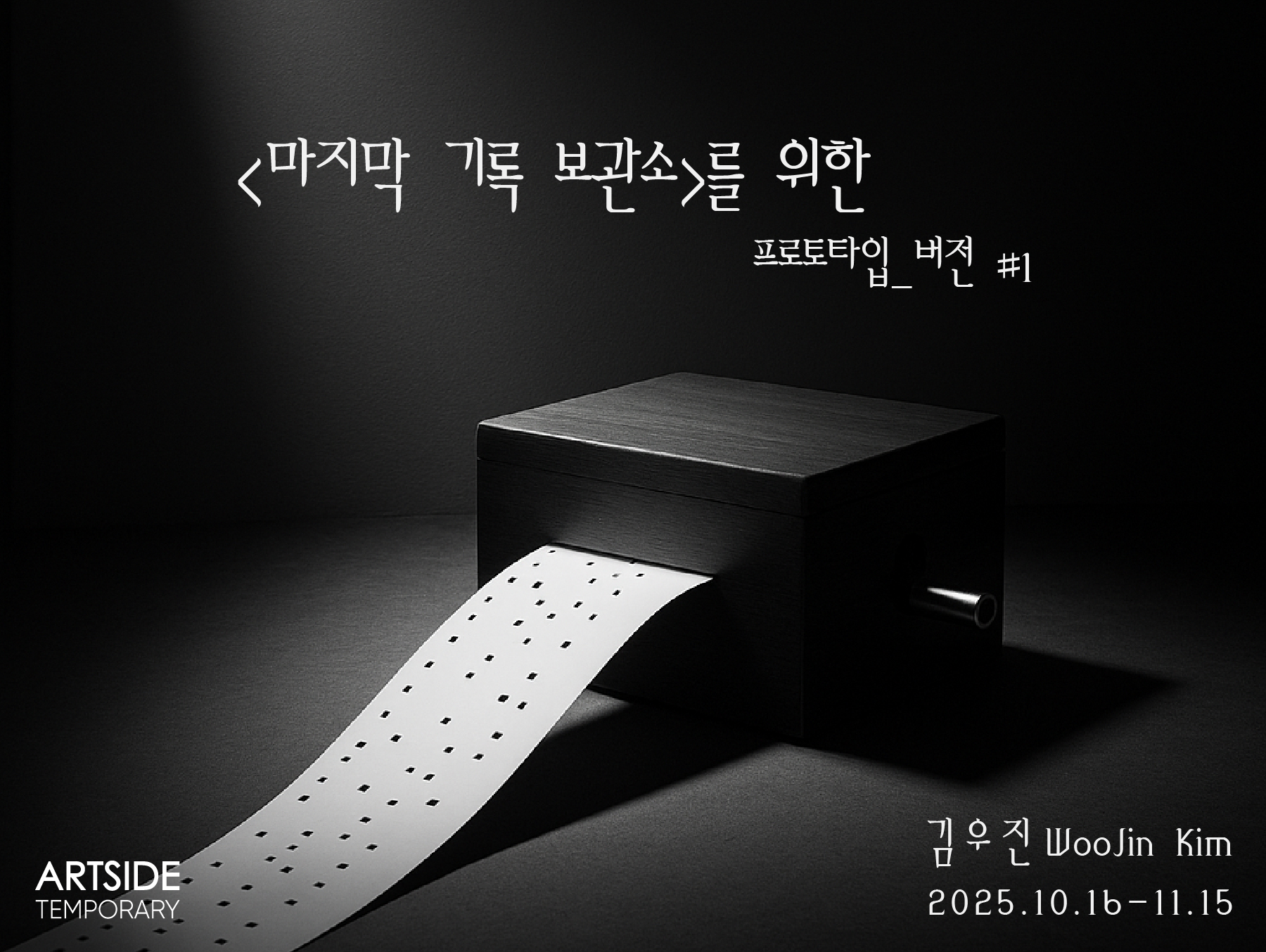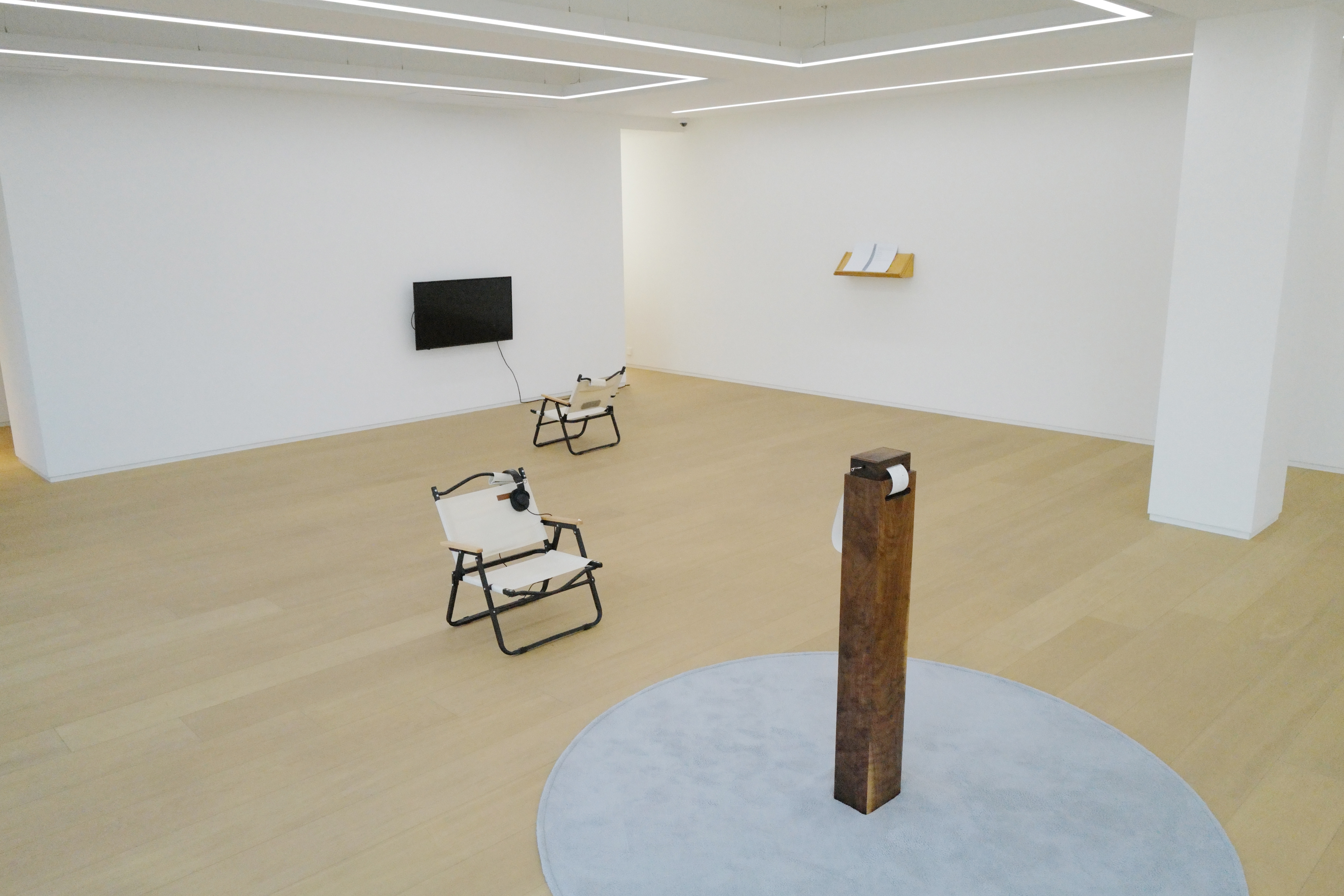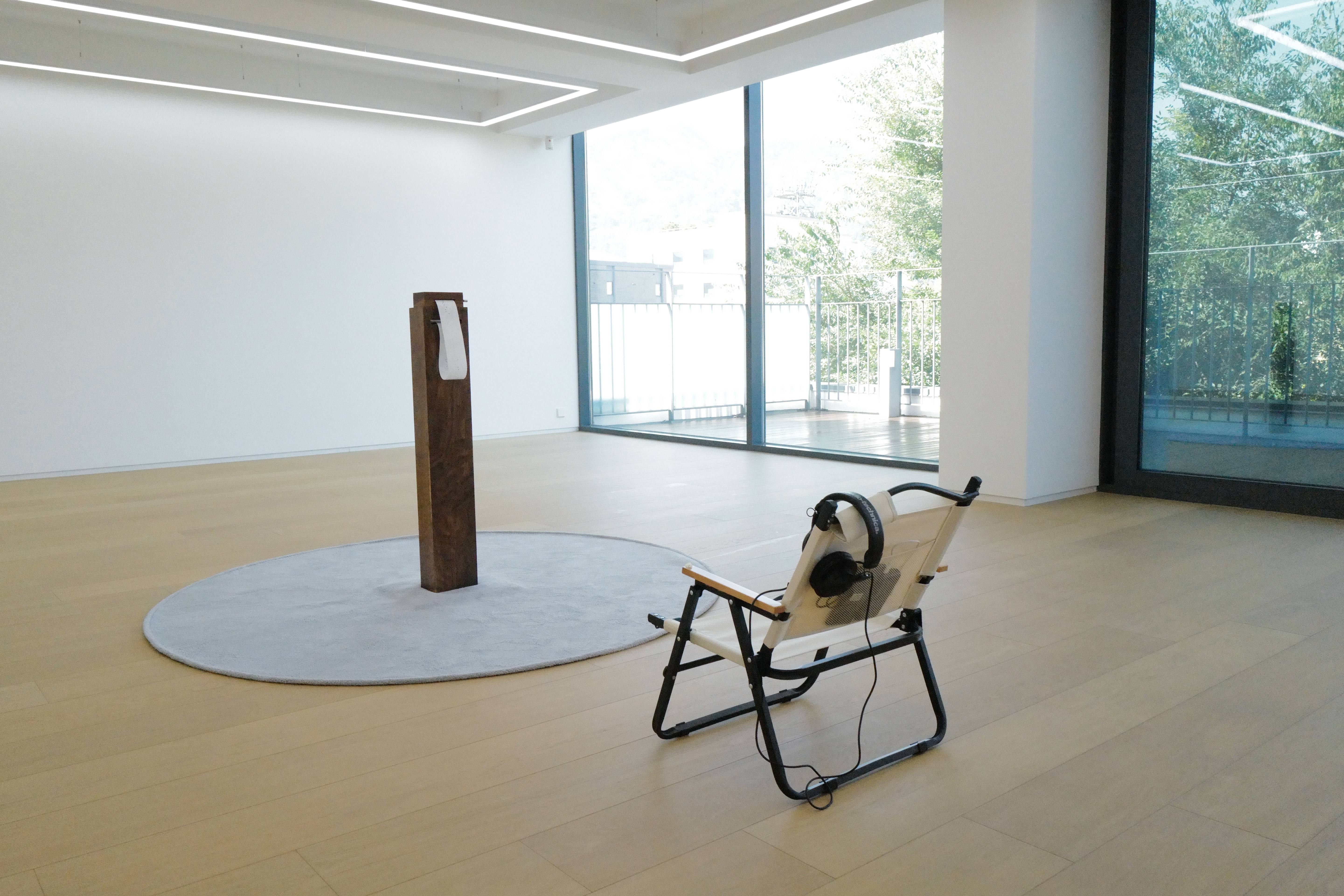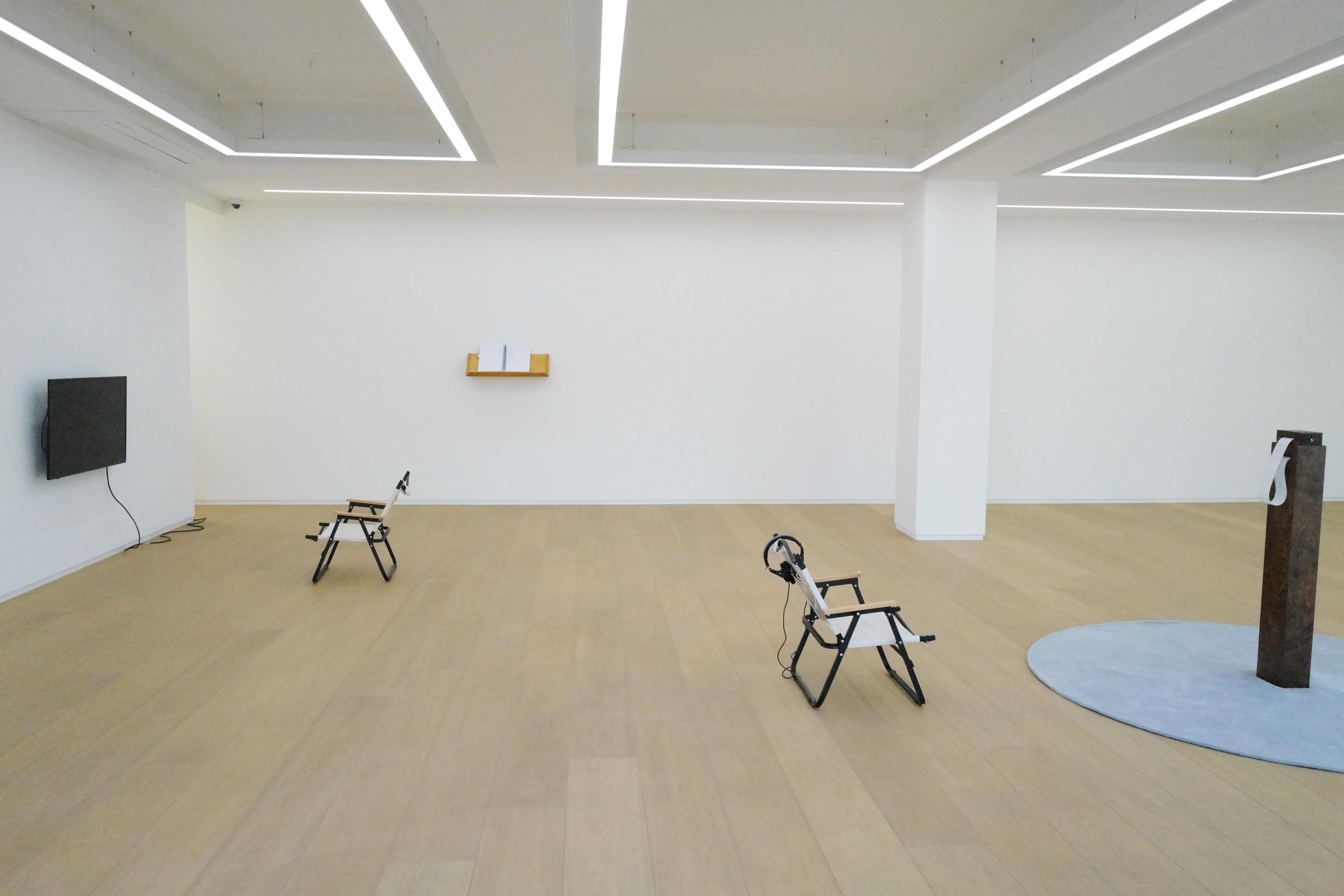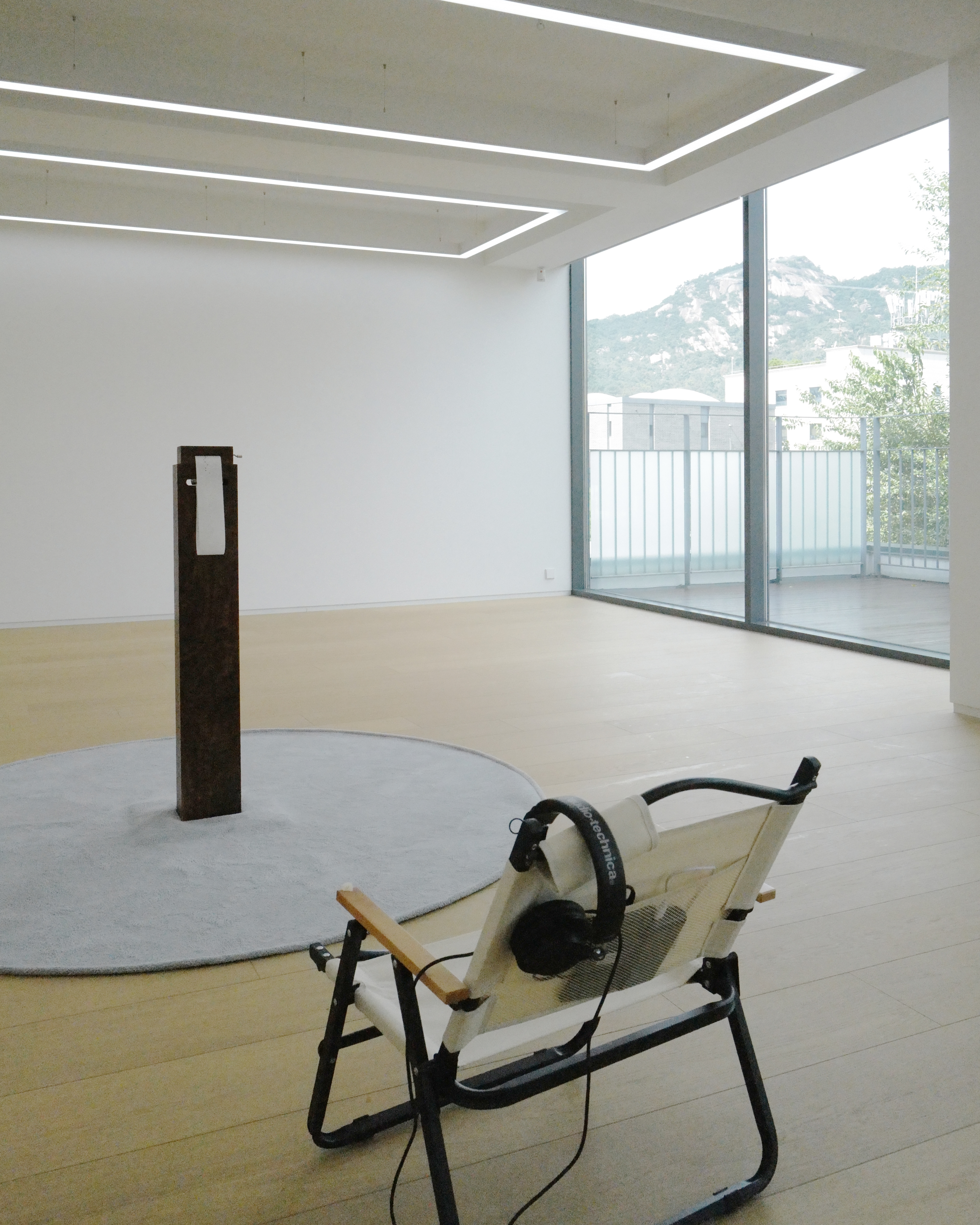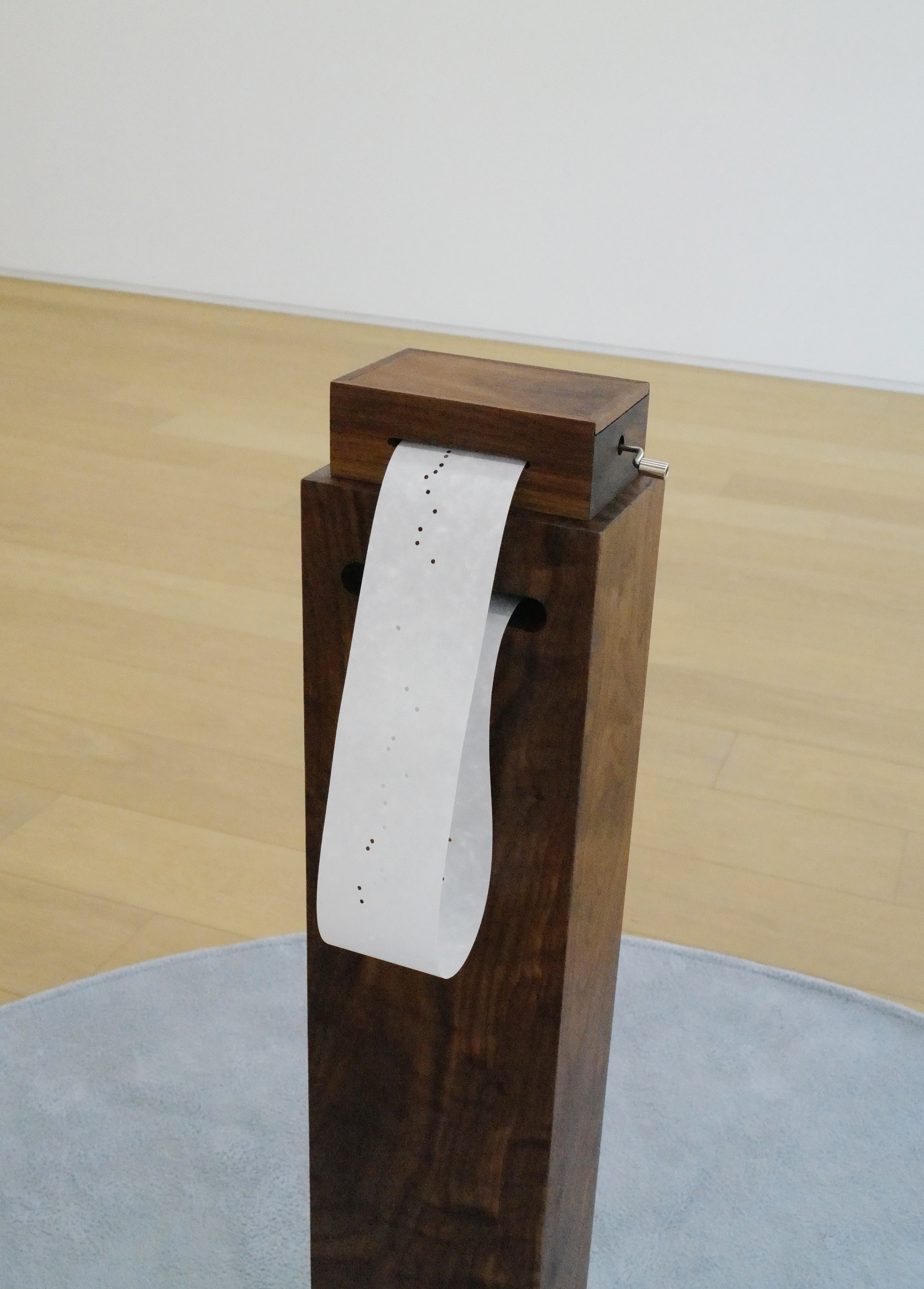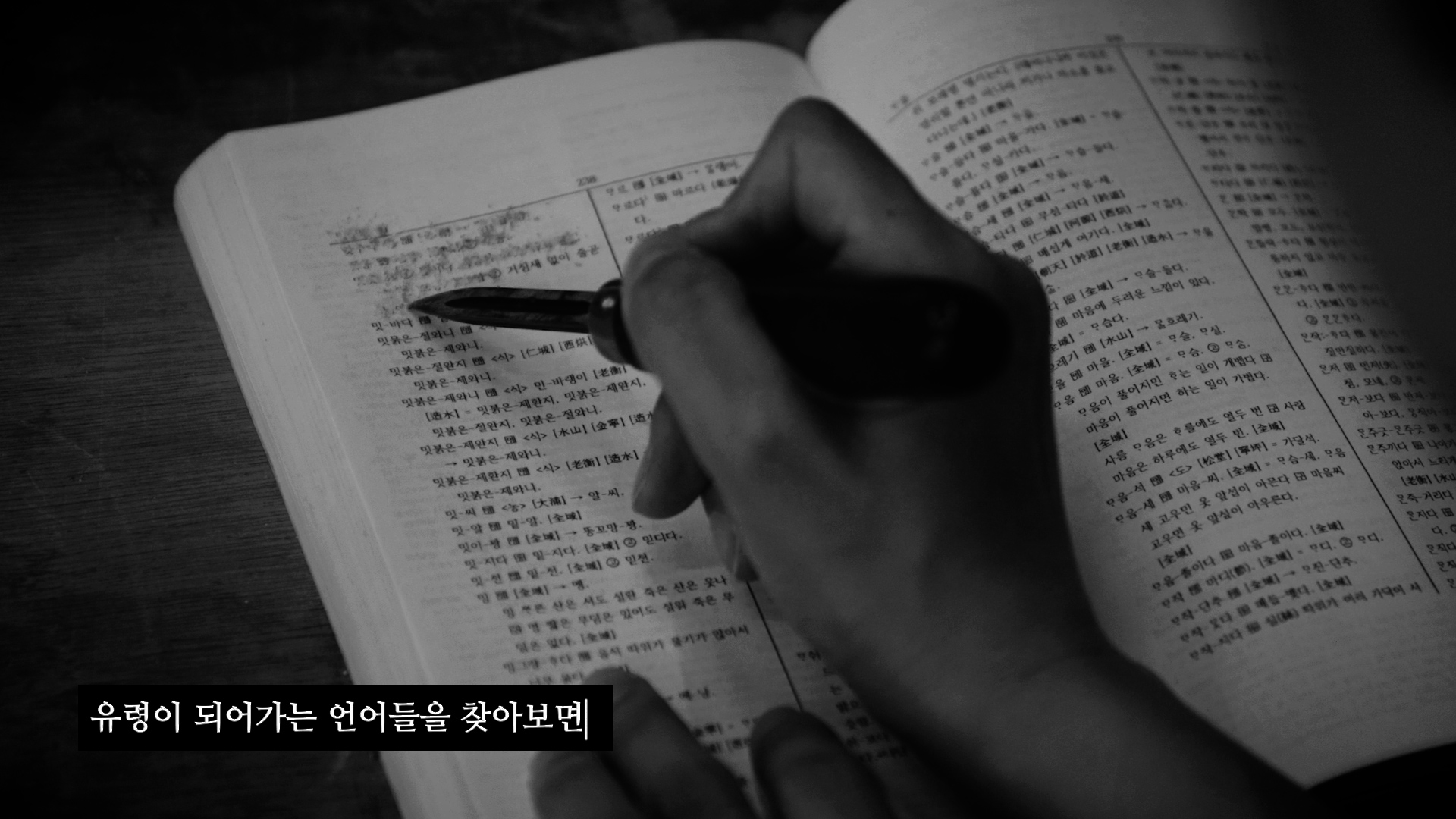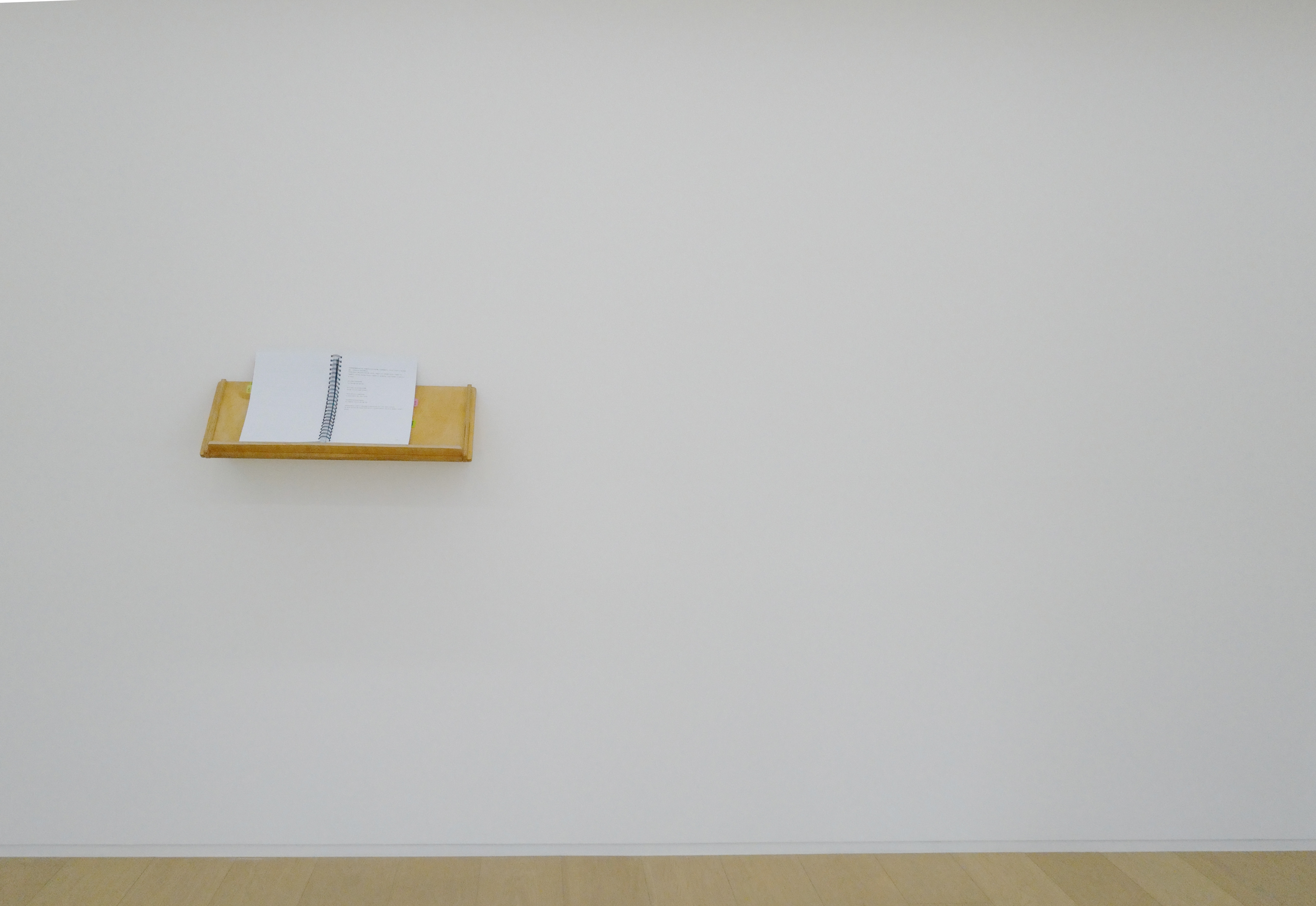Kim Woo Jin
- <마지막 기록 보관소>를 위한 프로토타입 #1
Oct. 16, 2025 - Nov. 15, 2025
아트사이드 템포러리에서는 10월 16일부터 11월 15일까지 사라지는 언어를 찾아다니고 이에 대한 기억을 수집하는 작업을 이어온 김우진 작가의 개인전 <마지막 기록 보관소>를 위한 프로토타입_버전#1을 진행한다.
언어는 공동체의 정체성과 기억을 보존하는 문화적 보관소이며 언어 소멸은 “집단적 기억 상실”에 비유되곤 한다. 아시아의 근현대 역사 속에서 언어는 정치적 격변에 따라 급속한 변화를 겪었고, 신자유주의 확산과 기술 발전은 자본과 연결되지 못한 단어들을 더욱 빠르게 도태시켰다. 세계 언어 데이터베이스에 따르면 현존하는 약 7,000개의 언어 중 2,500개 이상이 전승 단절의 위기에 처해 있으며, 평균적으로 매 2주마다 하나의 언어가 소멸하고 있다고 한다. 이들의 소멸은 곧 미래에 우리가 결코 알 수 없게 되는 지식의 상실을 의미한다.
예컨대 이번 전시에서 주로 다루고 있는 홋카이도의 원주민들이 사용했던 아이누어(アイヌ語)는 19세기 후반 메이지 정부의 동화 정책으로 전승이 끊겼다. 이들의 어휘 속에는 사냥, 어업, 자연환경에 관한 세밀한 지식이 축적되어 있어 아이누어의 소멸은 곧 북태평양 지역의 전통 생태 지식의 소멸을 의미한다.
김우진은 바로 이러한 언어 소멸의 현상과 그 안에 담긴 지식의 파괴에 주목해왔다. 그는 사회 속에 숨어 있는 다종의 프레임과 그것을 작동시키는 일상의 장치, 그리고 그것이 개인에게 은밀하게 영향을 미치는 방식에 지속적인 관심을 기울였다. 이번 전시는 이러한 궤적의 연장선상에서 현상에 대한 코멘트를 넘어 언어의 보전과 전승이라는 근본적인 문제에 초점을 맞춘다.
전시의 질문은 분명하다. “세대가 단절되고, 전기가 끊겨 디지털 기록조차 남지 않는 상황에서 언어를 어떻게 후대에 전할 수 있을까?” 이 물음에 대한 답으로 김우진은 노르웨이 스발바르(Svalbard)의 국제 종자 저장고에서 영감을 얻었다. 전 세계 종자은행의 복제본을 모아 인류의 식량을 위한 최후의 백업 시스템으로 기능하는 이 ‘노아의 방주’처럼, 김우진은 언어를 위한 방주, 곧 ‘마지막 기록 보관소’를 상정한다.
이 개념을 실험적으로 구현하는 과정에서 그는 언어의 본질이 발화되는 소리에 있다는 점에 주목했다. 김우진은 발음을 음으로 전환하는 방식을 실험하며 수동 오르골의 원리를 차용해 입모양,한글·영문 발음, 국제 음성 기호(IPA), 모스 부호를 함께 결합했다. 이로써 발음과 음이 남긴 흔적은 청각적·시각적 기호로 다시 읽히며 전기 없이도 언어의 소멸 앞에서 남길 수 있는 새로운 기록의 가능성을 제시한다.
이번 전시는 언어 보존을 위한 거대한 해답을 제시하기보다, 언어를 어떻게 기록하고 이어갈 수 있을지를 탐색한다. 관람자는 작가의 실험적 장치를 통해 언어가 지닌 기억과 지식이 어떤 방식으로 다음 세대에 남겨질 수 있을지 생각해 보게 될 것이다.
언어는 공동체의 정체성과 기억을 보존하는 문화적 보관소이며 언어 소멸은 “집단적 기억 상실”에 비유되곤 한다. 아시아의 근현대 역사 속에서 언어는 정치적 격변에 따라 급속한 변화를 겪었고, 신자유주의 확산과 기술 발전은 자본과 연결되지 못한 단어들을 더욱 빠르게 도태시켰다. 세계 언어 데이터베이스에 따르면 현존하는 약 7,000개의 언어 중 2,500개 이상이 전승 단절의 위기에 처해 있으며, 평균적으로 매 2주마다 하나의 언어가 소멸하고 있다고 한다. 이들의 소멸은 곧 미래에 우리가 결코 알 수 없게 되는 지식의 상실을 의미한다.
예컨대 이번 전시에서 주로 다루고 있는 홋카이도의 원주민들이 사용했던 아이누어(アイヌ語)는 19세기 후반 메이지 정부의 동화 정책으로 전승이 끊겼다. 이들의 어휘 속에는 사냥, 어업, 자연환경에 관한 세밀한 지식이 축적되어 있어 아이누어의 소멸은 곧 북태평양 지역의 전통 생태 지식의 소멸을 의미한다.
김우진은 바로 이러한 언어 소멸의 현상과 그 안에 담긴 지식의 파괴에 주목해왔다. 그는 사회 속에 숨어 있는 다종의 프레임과 그것을 작동시키는 일상의 장치, 그리고 그것이 개인에게 은밀하게 영향을 미치는 방식에 지속적인 관심을 기울였다. 이번 전시는 이러한 궤적의 연장선상에서 현상에 대한 코멘트를 넘어 언어의 보전과 전승이라는 근본적인 문제에 초점을 맞춘다.
전시의 질문은 분명하다. “세대가 단절되고, 전기가 끊겨 디지털 기록조차 남지 않는 상황에서 언어를 어떻게 후대에 전할 수 있을까?” 이 물음에 대한 답으로 김우진은 노르웨이 스발바르(Svalbard)의 국제 종자 저장고에서 영감을 얻었다. 전 세계 종자은행의 복제본을 모아 인류의 식량을 위한 최후의 백업 시스템으로 기능하는 이 ‘노아의 방주’처럼, 김우진은 언어를 위한 방주, 곧 ‘마지막 기록 보관소’를 상정한다.
이 개념을 실험적으로 구현하는 과정에서 그는 언어의 본질이 발화되는 소리에 있다는 점에 주목했다. 김우진은 발음을 음으로 전환하는 방식을 실험하며 수동 오르골의 원리를 차용해 입모양,한글·영문 발음, 국제 음성 기호(IPA), 모스 부호를 함께 결합했다. 이로써 발음과 음이 남긴 흔적은 청각적·시각적 기호로 다시 읽히며 전기 없이도 언어의 소멸 앞에서 남길 수 있는 새로운 기록의 가능성을 제시한다.
이번 전시는 언어 보존을 위한 거대한 해답을 제시하기보다, 언어를 어떻게 기록하고 이어갈 수 있을지를 탐색한다. 관람자는 작가의 실험적 장치를 통해 언어가 지닌 기억과 지식이 어떤 방식으로 다음 세대에 남겨질 수 있을지 생각해 보게 될 것이다.
At ARTSIDE Temporary, from October 16 to November 15, the gallery will present Prototype_Version #1 for The Last Archive, a solo exhibition by artist Kim Woojin, who has long pursued a practice of searching for disappearing languages and collecting memories associated with them.
Language is a cultural archive that preserves the identity and memory of a community, and language extinction is often compared to a form of “collective amnesia.” In modern and contemporary Asian history, languages underwent rapid transformations under political upheavals, while the expansion of neoliberalism and technological progress accelerated the elimination of words disconnected from capital. According to the World Language Database, out of approximately 7,000 existing languages, more than 2,500 are at risk of transmission being cut off, and on average one language disappears every two weeks. Their extinction signifies the irreversible loss of knowledge that future generations will never have access to.
For example, the exhibition highlights the Ainu language (アイヌ語) once spoken by the indigenous people of Hokkaido, which was cut off in the late 19th century under the assimilation policies of the Meiji government. The vocabulary of the Ainu carried intricate knowledge of hunting, fishing, and the natural environment, meaning that its extinction also represents the disappearance of traditional ecological knowledge from the North Pacific region.
Kim Woojin has long focused on this phenomenon of linguistic extinction and the destruction of knowledge it entails. She has consistently investigated the hidden frameworks embedded in society, the everyday devices that sustain them, and the subtle ways they exert influence on individuals. This exhibition, following the trajectory of her earlier inquiries, shifts from commentary on the phenomenon to address the fundamental issue of language preservation and transmission.
The central question of the exhibition is clear: “In a situation where generations are severed and electricity is cut off so that not even digital records remain, how can language be passed on to the future?” As a response, Kim draws inspiration from the Svalbard Global Seed Vault in Norway. Just as this “Noah’s Ark” functions as a final backup system for humanity’s food supply by collecting duplicates of seed banks worldwide, she envisions an ark for languages — The Last Archive.
In the experimental realization of this concept, the artist turns to the essential nature of language as sound produced in speech. She experiments with transforming pronunciation into musical notes, adopting the principle of a mechanical music box to combine mouth shapes, Hangul and English phonetics, the International Phonetic Alphabet (IPA), and Morse code. In this way, the traces left by sound and pronunciation reappear as both auditory and visual signs, suggesting the possibility of new forms of recording that could endure even in the face of linguistic extinction without electricity.
Rather than offering a definitive solution for language preservation, the exhibition explores how languages can be recorded and carried forward. Through the artist’s experimental devices, visitors are invited to reflect on how the memories and knowledge embedded in language might be transmitted to the next generation.
Language is a cultural archive that preserves the identity and memory of a community, and language extinction is often compared to a form of “collective amnesia.” In modern and contemporary Asian history, languages underwent rapid transformations under political upheavals, while the expansion of neoliberalism and technological progress accelerated the elimination of words disconnected from capital. According to the World Language Database, out of approximately 7,000 existing languages, more than 2,500 are at risk of transmission being cut off, and on average one language disappears every two weeks. Their extinction signifies the irreversible loss of knowledge that future generations will never have access to.
For example, the exhibition highlights the Ainu language (アイヌ語) once spoken by the indigenous people of Hokkaido, which was cut off in the late 19th century under the assimilation policies of the Meiji government. The vocabulary of the Ainu carried intricate knowledge of hunting, fishing, and the natural environment, meaning that its extinction also represents the disappearance of traditional ecological knowledge from the North Pacific region.
Kim Woojin has long focused on this phenomenon of linguistic extinction and the destruction of knowledge it entails. She has consistently investigated the hidden frameworks embedded in society, the everyday devices that sustain them, and the subtle ways they exert influence on individuals. This exhibition, following the trajectory of her earlier inquiries, shifts from commentary on the phenomenon to address the fundamental issue of language preservation and transmission.
The central question of the exhibition is clear: “In a situation where generations are severed and electricity is cut off so that not even digital records remain, how can language be passed on to the future?” As a response, Kim draws inspiration from the Svalbard Global Seed Vault in Norway. Just as this “Noah’s Ark” functions as a final backup system for humanity’s food supply by collecting duplicates of seed banks worldwide, she envisions an ark for languages — The Last Archive.
In the experimental realization of this concept, the artist turns to the essential nature of language as sound produced in speech. She experiments with transforming pronunciation into musical notes, adopting the principle of a mechanical music box to combine mouth shapes, Hangul and English phonetics, the International Phonetic Alphabet (IPA), and Morse code. In this way, the traces left by sound and pronunciation reappear as both auditory and visual signs, suggesting the possibility of new forms of recording that could endure even in the face of linguistic extinction without electricity.
Rather than offering a definitive solution for language preservation, the exhibition explores how languages can be recorded and carried forward. Through the artist’s experimental devices, visitors are invited to reflect on how the memories and knowledge embedded in language might be transmitted to the next generation.
